N the last few decades, aviators have continued to set new records. In 1977, American cyclist Bryan Allen used leg muscle to pedal the First human-powered aircraft, the Giwamer Connor A pedaling mechanism drove a propeller, powering the craft to 11 miles an hour. Alade of cardboard, aluminum, and plastic, the ultralight plane weighed 207 pounds, including the pilot! In 1980, Allen pedaled (hwamcrАІЬаІгом over the English Channel.
In 1986, pilots Dick Rutan and Jeana Yeager set a milestone aviation record, Hying nonstop around the world without refueling. They made the trip in nine days in the Voyanir. Extra fuel tanks were built in the plane’s long, thin wings.
Finally in 1999, the Brcilliny Orbilcr J, a shiny silver-colored balloon, made the first round-the-world balloon trip. Swiss pilot Bertrand Piccard and British co-pilot Brian Jones flew’ for 30,000 miles, crossing mountains, deserts, and the Pacific and Atlantic Oceans.
 Gossamer Albatross
Gossamer Albatross
In 1980, cyclist Bryan Allen test flies the Gossamer Albatross, a human-powered craft operated by pedaling. Flown by Allen, the Gossamer Albatross won the Kremer Prize for human-powered flight when it crossed the English Channel.
* Brutling Orbiter )
Covered with a skin of silver mylar, the Breitling Orbiter 3 was fi1 ed with helium and hot air. The balloon’s gondola (below) held tanks of propane fuel, oxygen to breathe, and tinycrewquarters. lt is today displayed in the Museum.
ElTLIN
BITER
For no it war…eery emotional to feel the luck ice had ^ to fly around tbit f, І beautiful world. ” ^ / ,
Of ‘ Щ
—Bertrand Piccard, co-pilot ; ,1
> Around the World in 20 Days
Breitling Orbiter 3 drifts over the Alps on its 30,000-mile journey around the globe in 1999.The long trip also set a balloon flight duration record of 19 days,
21 hours, and 55 minutes.
 ROCKETS have been around For centuries. The
ROCKETS have been around For centuries. The
Chinese used gunpowder rockets as weapons as early as the 13th century. They filled pointed bamboo tubes with gunpowder, sealed one end and lit the other. The explosion created a thrust, or pushing force, that propelled the rocket the opposite way. Rockets were later fired in the War of 1812. Francis Scott Key described their "red glare in the "Star Spangled Banner.”
In the 20th century, scientists developed rockets to explore space. Rocket engines arc the only engines that can operate in the vacuum of space. In space there is no air, and so no oxygen. Rockets carry both fuel and their own oxygen supply, called an oxidizer. Large rockets can also produce tremendous power, enough to escape Fai th s gravity. In 1926, American scientist Dr. Robert Goddard launched the first liquid – propellant rocket. He concluded that a rocket could be more efficiently propelled by liquid fuel. In World War II, Germany built powerful rocket weapons. Then in 1957, the Soviet Union stunned the world by using a rocket to launch the first Earth-orbiting satellite, Sputnik.
+ < V-2’Vengeance Weapon"
One of Germany’s most frightening weapons, a V-2 rocket roars into the sky during World War II. The first long-range ballistic missile, it carried 2,000 pounds of explosives. Over 3,000 were fired at Britain and other targets.
H Ready for Launch
Germans prepare a V-2 for launching. Small by modern standards, the V-2 was 46 feet tall. The forerunner of later rockets, it could race 150 miles in five minutes and destroy whole city blocks.
Inside the V-2
The V-2 got its powerful thrust by burning alcohol using liquid oxygen. These were mixed and ignited in a combustion chamber, creating hot gases. As they expanded they burst from the rocket’s nozzle, forcing it upward. The V-2’s explosives were carried in its nose.


Sputnik
On October 4,1957, a Soviet launched the first satellite. Sputnik ("Traveling Companion").A metal ball 23 inches across, it orbited Earth, sending "beep, beep" radio signals. A re Sputnik hangs in the Museum. [3]
Goddard щ Rocket
In 1941, Dr. Robert Goddard (top picture, left) examines one of his most advanced rockets as his assistants watch. This S^22-foot-high test rocket was fueled with gasoline and liquid oxygen. lt is today displayed in the National Air and Space Museum.
A 1935 A-3 Rocket
Three of Dr. Goddard’s assistants lift his liquid-fueled A-34ocket to fit it into a launch tower in Roswell, New Mexico. In the secluded southwest desert, Goddard tested many of his inventions.
Robert H. Goddard (1882-191,5)
Dr. Robert H. Goddard, inventor of the first flying liquid-propellant rocket, stands beside his creation. On March 16,1926, the Massachusetts physics professor launched the rocket from his aunt’s farm in Auburn, Massachusetts. Fueled with liquid oxygen and gasoline, it shot up 41 feet in 27: seconds oddard envisioned multi-stage rockets and using rockets to reach the Moon.
He is considered the father of American rocketry.


 THE space age began with the launch of Sputnik in 1957. In 1959, the United States began testing a new aircraft. Sleek, streamlined, and rocket- powered, the North American X-15 was the fastest, highest-flying airplane ever built. Its purpose was to fly to the end of the atmosphere and up into the edge of space. It gathered information that was later of great use to engineers planning a U. S. space program.
THE space age began with the launch of Sputnik in 1957. In 1959, the United States began testing a new aircraft. Sleek, streamlined, and rocket- powered, the North American X-15 was the fastest, highest-flying airplane ever built. Its purpose was to fly to the end of the atmosphere and up into the edge of space. It gathered information that was later of great use to engineers planning a U. S. space program.
The X-15 was made of a strong heat-resistant metal alloy to endure the heat of hypersonic (many times faster than sound) speeds. It was able to withstand 1,300 degrees Fahrenheit.
The X-15 flew to an incredible 354,200 feet, over 67 miles high, and reached a speed о f 4,520 miles an hour, or Mach 6.7. The pilot used air controls in the atmosphere and fired rocket thrusters to maneuver in space. I low did he know which controls to use? Test pilot Scott Crossfield said, “When one didn’t work, I simply used the other.”
► H2-F3 Lifting Body
 Another experimental vehicle was a wingless aircraft called a "lifting body." Launched in mid-air from a B-52, the craft could fly about 17 miles high a: nearfy 1,240 miles an hour. This Northrop M2-F3 now hangs in the Museum.
Another experimental vehicle was a wingless aircraft called a "lifting body." Launched in mid-air from a B-52, the craft could fly about 17 miles high a: nearfy 1,240 miles an hour. This Northrop M2-F3 now hangs in the Museum.







* Astronaut Wings
Five pilots who flew the X-15 went so high they were awarded astronaut wings for space travel. Space is considered to begin at an altitude of 50 miles. The X-15 flew to over 67 miles.
►North American X-15
In 1967, this rocket-powered research plane reached the threshold of space. It flew to 354,200 feet, a record for winged craft that still stands. One of the three X-15s built now hangs in the National Air and Space Museum.


 This F-18 has been modified to test a new feature. Strakes, hinged structures on its nose, open to stabilize the jet as it dives at a steep angle of attack. They give the pilot better handling in an otherwise dangerous maneuver.
This F-18 has been modified to test a new feature. Strakes, hinged structures on its nose, open to stabilize the jet as it dives at a steep angle of attack. They give the pilot better handling in an otherwise dangerous maneuver.
 A Lockheed F-117A Nighthawk
A Lockheed F-117A Nighthawk











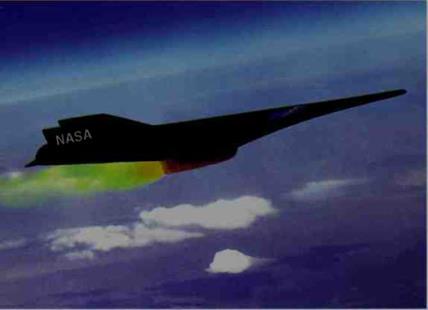
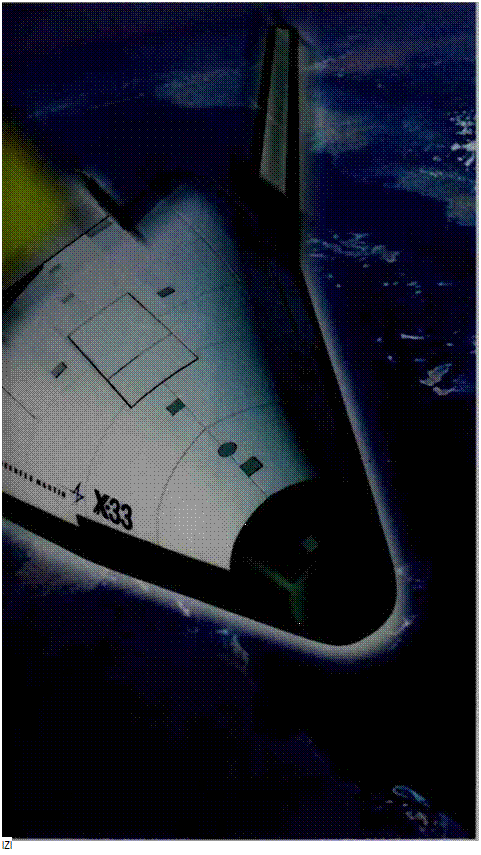
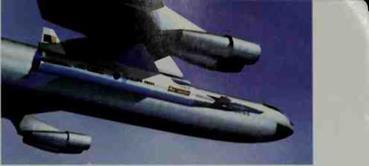
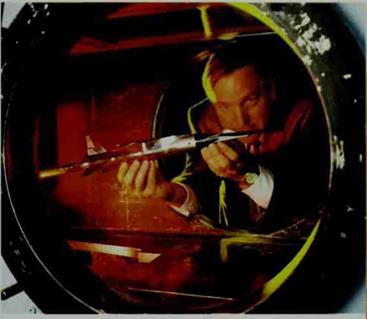 ► Mother Ship
► Mother Ship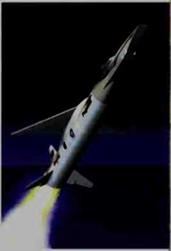

 7vs U-2 Нусог В came’ayow г the Museum, took retailed ground pictures of Cuba, ike the one at top center in the ‘960s/ney revealed Soviet missiles, which iec to the Cuban Missile Cr sis.
7vs U-2 Нусог В came’ayow г the Museum, took retailed ground pictures of Cuba, ike the one at top center in the ‘960s/ney revealed Soviet missiles, which iec to the Cuban Missile Cr sis.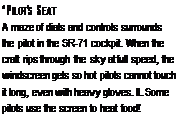
 Global Hawk
Global Hawk

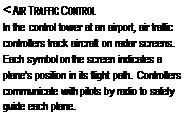








 NLIKE fixed-wing airplanes, helicopters have
NLIKE fixed-wing airplanes, helicopters have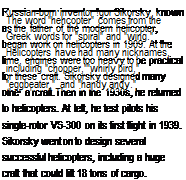







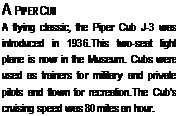



 Gossamer Albatross
Gossamer Albatross ROCKETS have been around For centuries. The
ROCKETS have been around For centuries. The


 THE space age began with the launch of Sputnik in 1957. In 1959, the United States began testing a new aircraft. Sleek, streamlined, and rocket- powered, the North American X-15 was the fastest, highest-flying airplane ever built. Its purpose was to fly to the end of the atmosphere and up into the edge of space. It gathered information that was later of great use to engineers planning a U. S. space program.
THE space age began with the launch of Sputnik in 1957. In 1959, the United States began testing a new aircraft. Sleek, streamlined, and rocket- powered, the North American X-15 was the fastest, highest-flying airplane ever built. Its purpose was to fly to the end of the atmosphere and up into the edge of space. It gathered information that was later of great use to engineers planning a U. S. space program. Another experimental vehicle was a wingless aircraft called a "lifting body." Launched in mid-air from a B-52, the craft could fly about 17 miles high a: nearfy 1,240 miles an hour. This Northrop M2-F3 now hangs in the Museum.
Another experimental vehicle was a wingless aircraft called a "lifting body." Launched in mid-air from a B-52, the craft could fly about 17 miles high a: nearfy 1,240 miles an hour. This Northrop M2-F3 now hangs in the Museum.




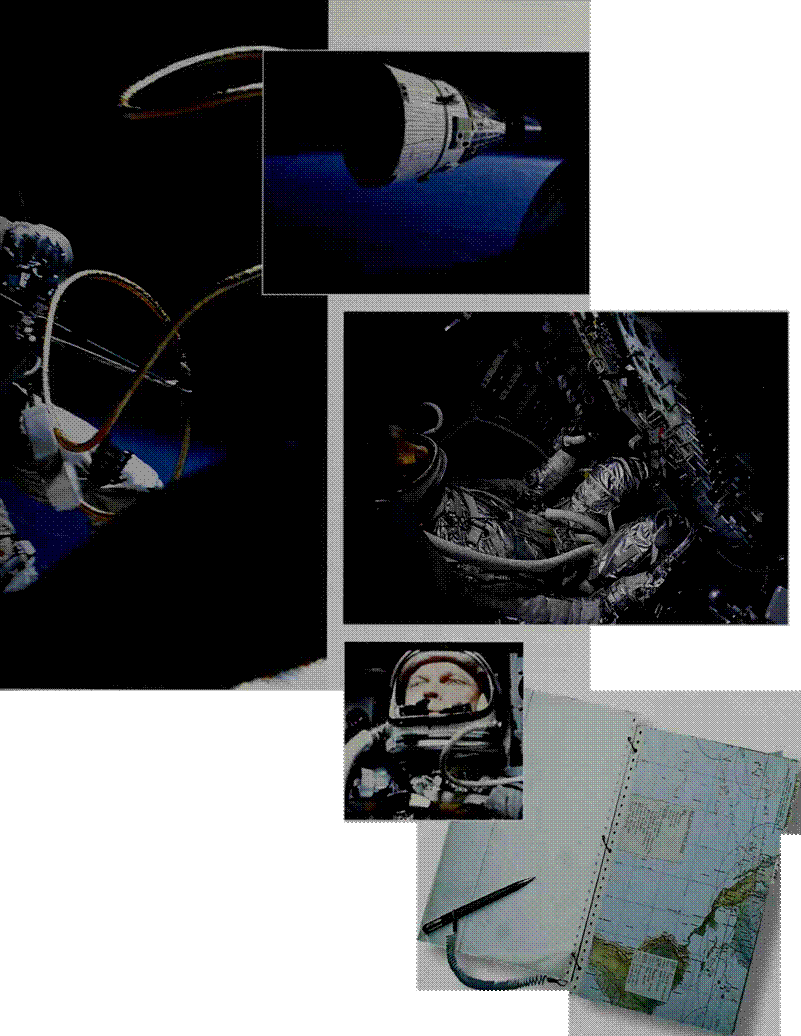


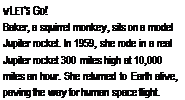
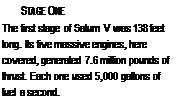
 HREE, two, one—we have liftoff!” With these words, rocket engines explode with a deafening roar, spewing out columns of fire and gas. Smoke billows into the sky and the ground shakes as the mighty engines thrust the rocket into the sky and send it hurtling toward space.
HREE, two, one—we have liftoff!” With these words, rocket engines explode with a deafening roar, spewing out columns of fire and gas. Smoke billows into the sky and the ground shakes as the mighty engines thrust the rocket into the sky and send it hurtling toward space.





 The Moon’s gravity is one-sixth that of Earth’s. This allowed the astronauts on the Moon to jump high easily. If you jumped lightly on the Moon, it would feel like bouncing on a trampoline.
The Moon’s gravity is one-sixth that of Earth’s. This allowed the astronauts on the Moon to jump high easily. If you jumped lightly on the Moon, it would feel like bouncing on a trampoline.
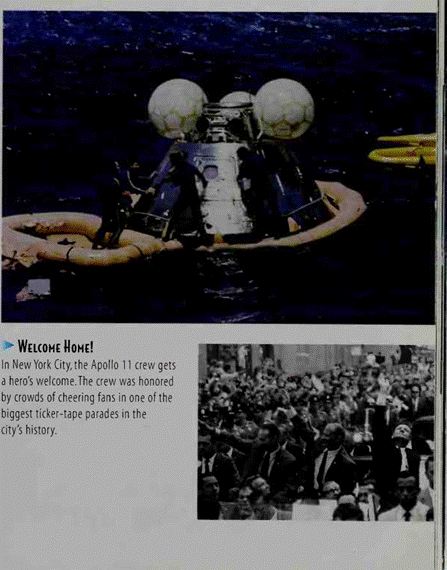

 The Lunar Rover was made of lightweight metal, mainly aluminum. It hail wire mesh tires to grip the dusty lunar surface. The battery- powered car had a TV camera, umbrella-shaped antenna, and tool rack. lt could travel 7 miles an hour. In it, the astronauts explored many miles from base.
The Lunar Rover was made of lightweight metal, mainly aluminum. It hail wire mesh tires to grip the dusty lunar surface. The battery- powered car had a TV camera, umbrella-shaped antenna, and tool rack. lt could travel 7 miles an hour. In it, the astronauts explored many miles from base.





 A total ol 12 men landed on the Moon. They gathered a vast store of knowledge. From rock and soil samples, scientists learned about the Moon’s formation, history, and chemistry. They discovered that iMoon minerals are similar to Earth’s but many have heavier iron and titanium content. They found the Moon has a very thin atmosphere of helium, hydrogen, argon, and neon. They also found that the Moon has a magnetic. field.
A total ol 12 men landed on the Moon. They gathered a vast store of knowledge. From rock and soil samples, scientists learned about the Moon’s formation, history, and chemistry. They discovered that iMoon minerals are similar to Earth’s but many have heavier iron and titanium content. They found the Moon has a very thin atmosphere of helium, hydrogen, argon, and neon. They also found that the Moon has a magnetic. field.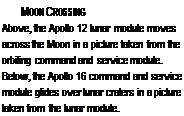
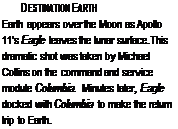
 Fun Fact: Long Way From Home
Fun Fact: Long Way From Home



